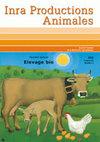畜牧业用水评估
IF 0.6
4区 农林科学
Q3 Agricultural and Biological Sciences
引用次数: 8
摘要
水资源短缺是供需关系的一个功能,是一个具有全球影响的区域问题,因为:(1)不断增长的人口和对动物产品的需求将增加对水的需求;(2)全球气候变化正在改变世界各地的降雨模式。水可分为“蓝”水(地表水和地下水)、“绿”水(受蒸散作用影响的土壤水)和“灰”水(将污染物稀释到可接受水平所需的水)。在全球范围内,农业占蓝水使用量的70%。所有评估用水的方法之间的一个主要区别是,它们是否以及如何将绿水和灰水与蓝水结合起来。“水足迹”方法包括绿水和灰水,而生命周期评估方法往往将它们排除在外,或者只包括土地利用变化导致的绿水可用性的变化。第二个不同之处在于,报告的用水量是用水量(L)还是用水压力指数(L水当量)加权的水量。由于这些差异以及所研究的牲畜系统很少,对于同一种牲畜产品,方法给出的结果截然不同。最终,水资源短缺取决于蓝水的使用。可以通过减少牲畜和(或)它们所消耗的灌溉作物的用水量来减少牲畜对水资源短缺的影响。本文章由计算机程序翻译,如有差异,请以英文原文为准。
Évaluation de l'utilisation de l'eau en élevage
Water scarcity, a function of supply and demand, is a regional issue with global repercussions, given that i) the increasing human population and demand for animal products will increase water demand and that ii) global climate change is altering rainfall patterns worldwide. Water can be divided into “blue” (surface and groundwater), “green” (soil water subject to evapotranspiration) and “grey” water (water necessary to dilute pollutants to acceptable levels). On a global scale, agriculture represents 70% of blue water use. One main difference among all methods for assessing water use is whether and how they include green and grey water with blue water. The “water footprint” approach includes green and grey water, whereas life cycle assessment approaches tend to exclude them or to include only the variation in green water availability resulting from land use change. A second difference is whether water use is reported as a volume of water (L) or a volume weighted by a water stress index (L water equivalents). Because of these differences and the few livestock systems studied, methods give wildly different results for the same livestock product. Ultimately, water scarcity depends on blue water use. The contribution of livestock to water scarcity can be reduced by decreasing their water consumption and/or that of the irrigated crops they consume.
求助全文
通过发布文献求助,成功后即可免费获取论文全文。
去求助
来源期刊

Inra Productions Animales
Multiple-
CiteScore
1.30
自引率
33.30%
发文量
0
审稿时长
>36 weeks
期刊介绍:
This journal publishes scientific update reports, results of experiments and their possible applications, analyses on topical issues and presentation of research, information on scientific events and new publications.
INRA Productions Animales deals with all species of zootechnical interest (herbivores, monogastrics and fish), covering feed and nutrition, physiology, pathology, genetics, production techniques, product quality and production economics.
 求助内容:
求助内容: 应助结果提醒方式:
应助结果提醒方式:


